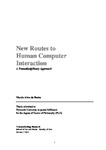New Routes to HCI - A transdisciplinary approach
| dc.contributor.supervisor | Punt, Michael | |
| dc.contributor.author | Rocha, Marcio | |
| dc.contributor.other | Faculty of Arts, Humanities and Business | en_US |
| dc.date.accessioned | 2015-11-06T12:27:49Z | |
| dc.date.available | 2015-11-06T12:27:49Z | |
| dc.date.issued | 2015 | |
| dc.identifier | 10321499 | en_US |
| dc.identifier.uri | http://hdl.handle.net/10026.1/3767 | |
| dc.description.abstract |
Abstract This thesis bring together different disciplines – philosophy of mind, artificial intelligence, cognitive science, cybernetics and the performing arts – in a transdisciplinary investigation that raises new questions about the human mind and our relationship with computers and machines in a way that contributes to and helps elucidate the human computer interaction (HCI) debate. It chooses transdisciplinarity as the methodology best able to mobilize new ideas and generate a different approach to HCI, one that will develop fresh insights and produce critical ways of thinking about the problems of contemporary life in relation to our interaction with technologies (in the broadest sense of the term). The thesis reconciles the artificial with human nature by using transdisciplinary methods to reduce the friction between human beings and computers. It does this by revisiting early mechanical machines and automatons (from mythology and science), as well as exploring the subject in relation to elements of the performing arts. In the process, the thesis confronts the concepts of ‘artificial’ and ‘natural’ intelligence, and explores various models of mind and intelligence, as well as examining the physicality or materiality of artefacts in terms of their congruence with the paradigm of the ‘embodied mind’. The preliminary studies and literature review carried out for the research revealed that the model of the mind currently proposed by HCI as the basis for theories of how humans interact with computers is unsatisfactory, limited and very problematic, not least because it is a disembodied and representational conception of the human mind. In order to relieve HCI of this problematic issue, the thesis introduces the concept of the ‘embodied mind’, which brings a deeper understanding of how the mind works; its recognition that the human mind, body and the world are interrelated entities gives us a new insight into how we can improve our interactions with machines and computers. To achieve this, the research explores the conceptualization of human characteristics such as intelligence and cognition, and confirms 7 that these concepts are subject to change, manifested in different forms, distributed, situated and contextualized. Intelligence is not interpreted as a literal entity, as it is in cognitive psychology, or as a quality that belongs to or empowers human beings alone, but inspired by the philosophy of artificial intelligence (AI), the thesis argues that it is a manifestation that ‘emerges’ when favourable conditions facilitate interactions between agents and artefacts. Through a focused analysis and interpretation of early automatons, robots, and artificial and mechanical machines, the study explores the concept that technology is both a practice and an imaginative idea, and not just a concrete manifestation of a solution to human problems. It perceives automatons, especially ‘fraudulent’ automatons, as true archaeological discoveries, evidence of the fact that our human ambitions and ideas are not limited by the technological expressions of different eras; they represent a special repository of the desire to capitalize on and make such ideas manifest even when the technology for their materialization is not yet available. The thesis also brings ventriloquism and puppetry into the discussion, as both objects and performative practices, in order to highlight the human relationship with the material environment, as well as related aspects of human and non-human agency. This indicates that cybernetics could prove a useful framework for an understanding of elements of the relationship between the human and the artificial. The thesis therefore tackles the problems and limitations imposed by cognitive science, computer science and psychology, currently the main disciplines concerned with improving human relationships with computers and machines, but more specifically, it offers a more historically and philosophically informed contribution to the study of HCI. | en_US |
| dc.description.sponsorship | CAPES - Ministry of Education - Brazil | en_US |
| dc.language.iso | en | en_US |
| dc.publisher | Plymouth University | en_US |
| dc.subject | Human Computer interaction | en_US |
| dc.subject | Interaction | |
| dc.subject | Mental Models | |
| dc.subject | Cybernetics | |
| dc.subject | Artificial Intelligence | |
| dc.title | New Routes to HCI - A transdisciplinary approach | en_US |
| dc.type | Thesis | |
| plymouth.version | Full version | en_US |
| dc.identifier.doi | http://dx.doi.org/10.24382/3956 |
Files in this item
This item appears in the following Collection(s)
-
01 Research Theses Main Collection
Research Theses Main


